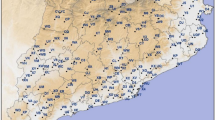Abstract
Changes in extreme meteorological variables and the demographic shift towards an older population have made it important to investigate the association of climate variables and hip fracture by advanced methods in order to determine the climate variables that most affect hip fracture incidence. The nonlinear autoregressive moving average with exogenous variable-generalized autoregressive conditional heteroscedasticity (ARMAX-GARCH) and multivariate GARCH (MGARCH) time series approaches were applied to investigate the nonlinear association between hip fracture rate in female and male patients aged 40–74 and 75+ years and climate variables in the period of 1993–2004, in Montreal, Canada. The models describe 50–56 % of daily variation in hip fracture rate and identify snow depth, air temperature, day length and air pressure as the influencing variables on the time-varying mean and variance of the hip fracture rate. The conditional covariance between climate variables and hip fracture rate is increasing exponentially, showing that the effect of climate variables on hip fracture rate is most acute when rates are high and climate conditions are at their worst. In Montreal, climate variables, particularly snow depth and air temperature, appear to be important predictors of hip fracture incidence. The association of climate variables and hip fracture does not seem to change linearly with time, but increases exponentially under harsh climate conditions. The results of this study can be used to provide an adaptive climate-related public health program and ti guide allocation of services for avoiding hip fracture risk.






Similar content being viewed by others
References
Benetos LS, Babis GC, Zoubos AB, Benetou V, Soucacos PN (2007) Factors affecting the risk of hip fractures. Inj Int J Care Inj 38:735–744
Bischoff-Ferrari HA, Orav JE, Barrett JA, Baron JA (2007) Effect of seasonality and weather on fracture risk in individuals 65 years and older. Osteoporos Int 18:1225–1233
Bollerslev T (1990) Modeling the coherence in short-run nominal exchange rates: a multivariate generalized ARCH model. Rev Econ Stat 72:498–505
Bulajic-Kopjar M (2000) Seasonal variations in incidence of fractures among elderly people. Inj Prev 6:16–19
Cummings SR, Melton JR III (2002) Epidemiology and outcomes of osteoporotic fractures. Lancet 359:1761–1767
Edvardsen K, Engelsen O, Brustad M (2009) Duration of vitamin D synthesis from weather model data for use in prospective epidemiological studies. Int J Biometeorol 53:451–459
Engle RF, Kroner KF (1995) Multivariate simultaneous generalized ARCH. Econ Theory 11:122–150
Gullberg B, Duppe H, Nilsson B, Redlund-Johnell I, Sernbo I, Obrant K, et al (1993) Incidence of hip fractures in Malmo, Sweden (1950–1991). Bone 14(Suppl 1):S23–S29
Gronskag AB, Siri F, Romundstad P, Langhammer A, Schei B (2010) Incidence and seasonal variation in hip fracture incidence among elderly women in Norway. The HUNT study. Bone 46:1294–1298
Hamilton JD (1994) Time series analysis. Princeton University Press
Harvey N, Dennison E (2010) Osteoporosis: impact on health and economics. Nat Rev Rheumatol 6:99–105
Lambert LJ, Blais C, Hamel D, Brown KA, Giguere M et al (2010) Reliability of the assessment of pattern comorbidities using Quebec’s medico-administrative data. Can J Cardiol 26(Supplement D):29D
Lan TY, Hou CY, Chen CY, Chang WC, Lin J, Lin CC et al (2010) Risk factures for hip fracture in older adults: a case–control study in Taiwan. Osteoporos Int 21:773–784
Lemmen DS, Warren FJ, Lacroix J, Bush E (2008) From impacts to adaptation: Canada in a changing climate 2007. Ottawa: Government of Canada; 2008. http://adaptation.nrcan.gc.ca/assess/2007/index_e.php. Accessed 28 July 2011
Levy AR, Tamblyn RM, Fitchett D, McLeod PJ, Hanley JA (1999) Coding accuracy of hospital discharge data for elderly survivors of myocardial infarction. Can J Cardiol 15:1277–1282
Lin HC, Xiraxagar S (2006) Seasonality of hip fracture and estimates of season attributable effects: a multivariate ARIMA analysis of population-based data. Osteoporos Int 17:795–806
Lofthus CM, Osnes EK, Falch JA, Kaasad TS, Kristiansen IS, Nordsletten L (2001) Epidemiology of hip fractures in Oslo, Norway. Bone 29:413–418
Masud T, Morris RO (2001) Epidemiology of falls. Age Ageing 30 (supplement 3–7)
Mirchandani S, Aharonoff GB, Hiebert R, Capla EL, Zuckerman JD, Koval KJ (2005) The effects of weather and seasonality on hip fracture incidence in older adults. Orthopedics 28:149–155
Modarres R, Ouarda TBMJ, Vanasse A, Orzanco MG, Gosselin P (2012) Modeling seasonal variation of hip fracture in Montreal, Canada. Bone 50:909–916
Oven KJ, Curtis SE, Reaney S, Riva M, Stewart MG et al (2012) Climate change and health and social care: defining future hazard, vulnerability and risk for infrastructure systems supporting older people’s health care in England. Appl Geogr 33:16–24
Quigley PA, Campbell RR, Bulat T, Olney RL, Buerhaus P, Needleman J (2012) Incidence and cost of serious fall-related injuries in nursing homes. Clin Nurs Res 21:10–23
Sumukadas D, Witham M, Struthers A, Mcmurdo M (2009) Day length and weather conditions profoundly affect physical activity levels in older functionally impaired people. J Epidemiol Community Health 63:305–309
Tenias JM, Estarlich M, Fuentes-Leonarte V, Iniguez C, Ballester F (2009) Short-term relationship between meteorological variables and hip fractures: an analysis carried out in a health area of the Autonomous Region of Valencia, Spain (1996–2005). Bone 45:794–798
Turner RM, Hayen A, Dunsmuir WT, Finch CF (2011) Air temperature and the incidence of fall-related hip fracture hospitalisations in older people. Osteoporos Int 22:1183–1189
Acknowledgments
The work was supported by the Institut National de Santé Publique du Québec (INSPQ) and the Institut National de la Recherche Scientifique—Centre Eau, Terre et Environnement (INRS-ETE), the Green Fund in the framework of Action 21 of the Government of Québec’s 2006–2012 Climate Change Action Plan and the Network of Centers of Excellence GEOIDE and the Fonds de Recherche en Santé du Québec (FRSQ).
Author information
Authors and Affiliations
Corresponding author
Electronic supplementary material
Below is the link to the electronic supplementary material.
ESM 1
(DOC 1669 kb)
Rights and permissions
About this article
Cite this article
Modarres, R., Ouarda, T.B.M.J., Vanasse, A. et al. Modeling climate effects on hip fracture rate by the multivariate GARCH model in Montreal region, Canada. Int J Biometeorol 58, 921–930 (2014). https://doi.org/10.1007/s00484-013-0675-6
Received:
Revised:
Accepted:
Published:
Issue Date:
DOI: https://doi.org/10.1007/s00484-013-0675-6




